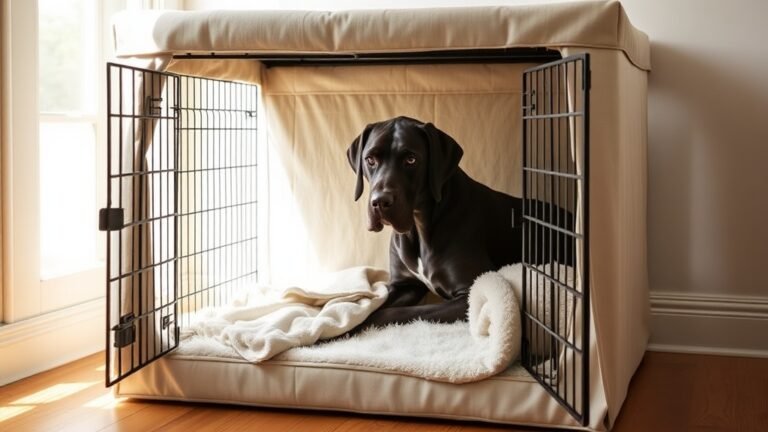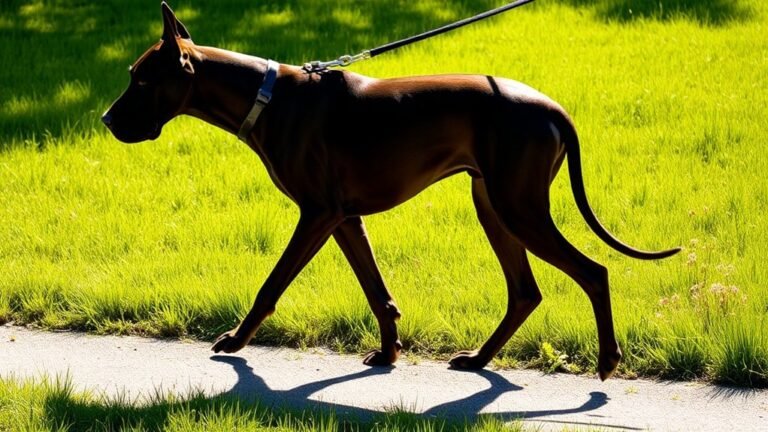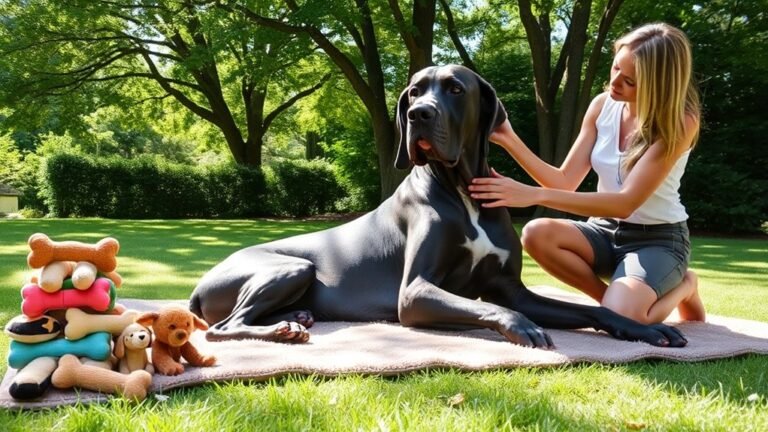3 AM Bark Symphony—My Gift to the Neighborhood

Great Dane & Nighttime Barking
So you’re wondering why I bark when the sun goes down? Well, let me explain from my point of view! First off, being alone is scary when it’s dark. I mean, I’m huge, but that doesn’t mean I don’t get lonely! When you all go to sleep, I feel like I’m the only one protecting our house. That’s a big job for one dog.
Those weird sounds outside don’t help either. Do you hear that raccoon knocking over trash cans? Or that cat walking on our fence like it owns the place? My job is to tell you about these critical security updates, even if it’s 2 AM. I know you might not appreciate my loud announcements, but I’m just doing my duty!
Sometimes my tummy rumbles too. Growing this big takes a lot of food, and if I missed dinner or it was too small, I might bark to remind you about snacks. A hungry Great Dane is not a quiet Great Dane.
If I’m not feeling well, barking is how I tell you something’s wrong. We can’t exactly send you a text message when our stomach hurts or we’re feeling anxious.
Want to help me be quieter? Make bedtime calm and peaceful. Stick to our daily routine because I love knowing what comes next. And please check if I’m feeling sick or worried about something. Trust me, I’d rather sleep peacefully, too!
Understanding Great Dane Barking Behavior
Hi there, humans! I’m a Great Dane, and I’ve got some big thoughts about our barking habits. Trust me, when you’re as tall as I am, people notice when you have something to say!
First off, we don’t just bark to hear our own voices (though we do have pretty impressive ones). When I bark, I’m trying to tell you something important! Maybe I’m super excited because you just came home, or I spotted a suspicious squirrel in MY yard.
We don’t bark just to make noise; we’re sharing important news, like your arrival or a squirrel sighting!
Sometimes I bark because I’m worried about something – like when the doorbell rings and I don’t know who’s visiting.
You humans might think we’re just being loud, but we’re actually pretty competent communicators. When I give a quick, happy bark, I’m usually saying, “Hey, let’s play!”
But when I do my deep, serious bark, I’m telling you, “Pay attention – something’s up!”
The funny thing is, we Great Danes sometimes forget how big we are. I might bark at a tiny dog, thinking I’m being friendly, but then I accidentally scare them because my voice is so booming. Oops!
Here’s a secret: we bark because we love our families. We want to protect you, play with you, and make sure you know what’s happening in our world. Structured bedtime routines can also help reduce our nighttime barking, making for a more peaceful night for everyone!
Common Causes of Nighttime Barking
Why We Great Danes Bark at Night (And Why You Shouldn’t Be Mad!)
Hey humans! I know you get pretty grumpy when we bark at night, but trust me – we’ve our reasons! Let me explain what’s going on in our giant heads when the sun goes down.
First off, nighttime can get pretty lonely down here. When you all disappear into your cozy beds, we’re left wondering if you’ve abandoned us forever.
A little “woof” is just our way of checking – “Hey, are you still there? Did you forget about your favorite four-legged family member?”
We’re furry security guards, and we’re good at our job.
Sometimes our stomachs start rumbling around midnight. You know how cranky you get when you’re hungry? Well, imagine being 150 pounds and having an empty belly.
A few barks might remind you that dinner was a long time ago.
And honestly, sometimes we just really need to go outside for a bathroom break. We’re trying to be polite here!
Would you rather we bark or have an accident on your favorite rug? It’s important to remember that early socialization helps us feel more secure and less anxious at night.
Identifying Behavioral and Environmental Triggers
Why Do I Bark at Night? Let Me Explain!
I need to tell you something important about my nighttime singing sessions (you call it “barking,” but I prefer “vocal performances”).
Want to know why I suddenly turn into a furry alarm system when the sun goes down? Let me spill the kibble on this mystery! First, you need to oversee me. Am I woofing at that weird shadow moving outside? That scary garbage truck rumbling down the street? Or maybe that sneaky squirrel is plotting world domination in our backyard? Trust me, these are all essential things that need my immediate attention!
Here’s the thing – I’m not just making noise for fun (okay, maybe a little bit for fun). My super-hearing picks up sounds you can’t even detect! That neighbor’s cat tiptoeing across the fence? RED ALERT! The wind rustling those suspicious leaves? DEFINITELY worth investigating! Even changes in lighting can make me think something’s up. When everything looks different at night, my inner security guard kicks into overdrive.
My humans started keeping a little notebook about my barking habits, and honestly, it’s pretty smart! They write down what time I bark, what I’m looking at, and what’s happening outside. It’s like being a detective, but for dog behavior!
Once you figure out what triggers my vocal cords, we can work together to help me relax at bedtime. Because let’s be real – even us Great Danes need our beauty sleep! Remember, regular exercise needs are essential to keep my energy levels in check so I can settle down at night.
Effective Management and Training Strategies
Woof! Let me tell you about my nighttime barking situation from my perspective. My humans think they need to “manage” me, but really, we just need to work together better!
First off, I’m HUGE and my bark is naturally loud. When I hear weird noises at 2 AM, I’m just doing my job as the family protector! But I’ve learned that constant barking makes everyone grumpy, including me.
I’m a big dog with a loud bark, protecting my family at 2 AM, but I’ve learned quiet makes us all happier!
Here’s what actually works when my humans and I team up:
- Making my sleeping spot super cozy helps me chill out. A comfy bed and maybe some soft music? Perfect!
- When I stay quiet during strange noises, treats appear like magic. I’m starting to think quiet time equals snack time.
- My humans have been playing recordings of scary nighttime sounds during the day, then giving me treats when I don’t bark. Weird training method, but hey, free food!
- Keeping my dinner and walk times the same every day helps my giant body know when it’s actually time to sleep versus guard duty.
The truth is, I want everyone to sleep well. I just needed to learn that not every little sound requires my booming announcement to the neighborhood. Practicing short absences from my humans during the day also helps me feel more secure at night.
Now we’re all happier – and I still get to be the best guard dog ever!
Health Considerations Impacting Barking Frequency
Woof! Let me tell you something about why us Great Danes might bark more than our humans would like. Sometimes we’re not just being dramatic (okay, maybe we’re a little dramatic – we’re the theater kids of the dog world).
Here’s the thing – when my giant body hurts, I’m gonna let everyone know about it! If my joints are achy from arthritis or I’m feeling sick, barking is my way of saying, “Hey, humans, something’s not right over here!” It’s like when you stub your toe and yell “OW!” except I do it with my impressive vocal cords that can probably wake up the whole neighborhood.
Sometimes I get worried or scared, too. Maybe there’s a scary leaf blowing around outside, or I heard a mysterious sound that could definitely be a squirrel plotting something suspicious. When my anxiety kicks in, my mouth just starts going like a broken car alarm.
And don’t even get me started on getting older. Sometimes my brain gets a little foggy, and I forget why I started barking in the first place. But hey, I’m already committed to the bit, so I might as well keep going!
If your humans notice you’re barking more than usual, they should probably take you to see the vet. Those lovely people in white coats can figure out if something’s bothering you, especially since conditions like dilated cardiomyopathy can cause changes in behavior.
Trust me, it’s better than having your humans try to guess what’s wrong while you’re doing your best impression of a fire truck siren at 2 AM.
Final Thoughts
To sum up, dealing with my nighttime barking can make life way better for everyone in our house! Did you know that almost 30% of dog families deal with us pups barking at night? It’s pretty common! When my humans figure out what makes me “woof” in the dark and teach me better habits, everyone sleeps much better. I know I can be loud sometimes – my bark is HUGE because, well, I’m huge! But my family needs to be patient with me while we figure this out together. Trust me, I want everyone to be happy, including me. We Great Danes are gentle giants who need a little help learning the house rules!






4 Comments